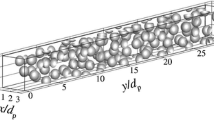Abstract
Quantification of mass transfer processes across micro-porous membranes can give valuable insight in applications of industrial and medical relevance. In this paper, a hybrid lattice Boltzmann-Finite differences (LBM-FD) code with non-uniform grid that simulates the mass transfer on a chip-like micro-device with an embedded micro-porous membrane has been developed. The model is validated showing good agreement with results of the Graetz-Leveque problem, even for Péclet numbers above 106, where conventional numerical methods fail to predict the correct behavior. The errors obtained in our simulations are below 1%. Simulations of the micro-porous membrane model in two and three dimensions show a linear scaling of the average Sherwood number with the number of pores and a value 1/3 of the scaling exponent of the Péclet number.













Similar content being viewed by others
References
Kenig EY, Su Y, Lautenschleger A, chasanis P, Grünewald M (2013) Micro-separation of fluid systems: a state-of-the-art review. Sep Purif Technol 120:245–64
Chabanon E, Belaissaoui B, Favre E (2014) Gas-liquid separation processes based on physical solvents: opportunities for membranes. J Membr Sci 459:52–61
Al-Marzouqi M, El-Naas MH, Marzouk SA, Al-Zarooni MA, Abdullatif N (2008) Modeling of CO2 absorption in membrane contactors. Sep Purif Technol 59:286–93
Liu H et al (2016) Multiphase lattice Boltzmann simulations for porous media applications. Comput Geosci 20:777–805
Zhang W, Li J, Chen G, You W, Ren Z (2010) Simulations of solute concentration profile and mass transfer behavior near the membrane surface with finite volume method. J Membr Sci 355:18–27
Zhang W, Hao Z, Chen G, Li J, Li Z, Wang Z, Ren Z (2014) Effect of porosity on mass transfer of gas absorption in a hollow fiber membrane contactor. J Membr Sci 470:399–410
Zhang W, Li J, Chen G, You W, Jiang Y, Sun W (2010) Experimental study of mass transfer in membrane absorption process using membranes with different porosities. Ind Eng Chem Res 49:6641–48
Miranda JM, Campos JBLM (2001) An improved numerical scheme to study mass transfer over a separation membrane. J Membr Sci 188:49–59
Miranda JM, Campos JBLM (2002) Mass transfer in the vicinity of a separation membrane-the applicability of the stagnant film theory. J Membr Sci 202:137–50
Miranda JM, Campos JBLM (2007) Numerical study of a hybrid membrane cell with semi and fully permeable membrane sub-sections. Chem Eng Sci 62:1215–29
Li C, Wagner M, Lackner S, Horn H (2016) Assessing the influence of bio?lm surface roughness on mass transfer by combining optical coherence tomography and two-dimensional modeling. Biotechnol Bioeng 113(5):989–1000
Huh D, Matthews BD, Mammoto A, Montoya-Savala M, Hsin HY, Ingber DE (2010) Reconstituing organ-level lung functions on a chip. Science 328:1662–68
Leveque A (1928) Les lois de la de la transmission de chaleur par convection. Ann des Mines 13:201–99
Li Q, Zhou P, Yan HJ (2016) Revised Chapman-Enskog analysis for a class of forcing schemes in the lattice Boltzmann method. Phys Rev E 94:043313
Holzbecher E (2008) Numerical solutions for the Leveque problem of Boundary Layer mass or heat flux. Excerpt from the Proceedings of the COMSOL Conference Hannover
Acknowledgements
Support from the Spanish Ministerio de Economía y Competitividad under grants CTQ2013-46799-C2-1-P and DPI2016-75791-C2-1-P is gratefully acknowledged.
Author information
Authors and Affiliations
Corresponding author
Additional information
Publisher’s Note
Springer Nature remains neutral with regard to jurisdictional claims in published maps and institutional affiliations.
Rights and permissions
About this article
Cite this article
Giraldo, J.F., Cito, S., Vernet, A. et al. Multi-scale hybrid numerical model for the study of mass transfer through a microporous artificial membrane. Heat Mass Transfer 54, 3707–3714 (2018). https://doi.org/10.1007/s00231-018-2395-2
Received:
Accepted:
Published:
Issue Date:
DOI: https://doi.org/10.1007/s00231-018-2395-2




